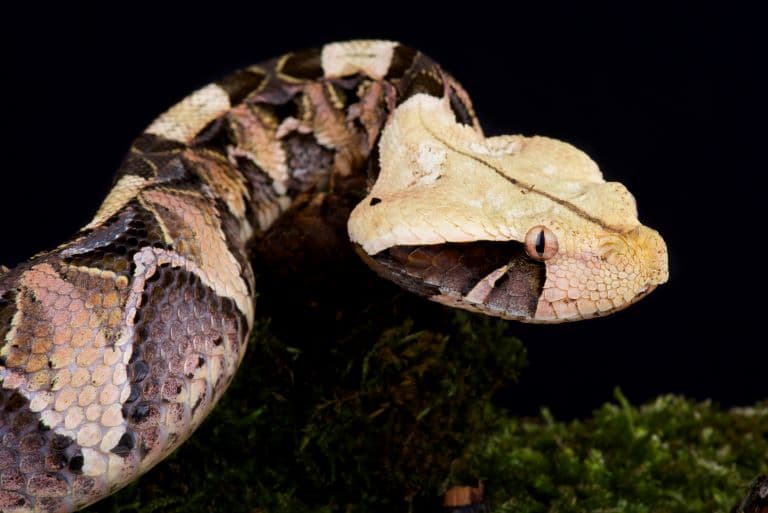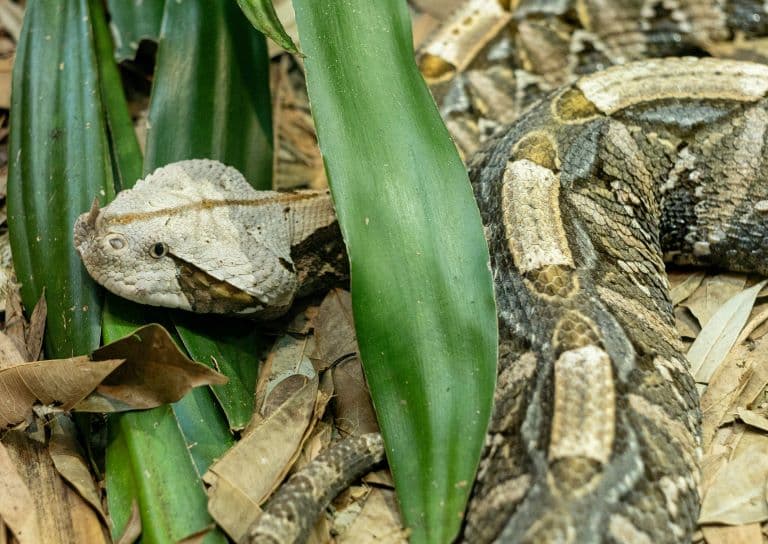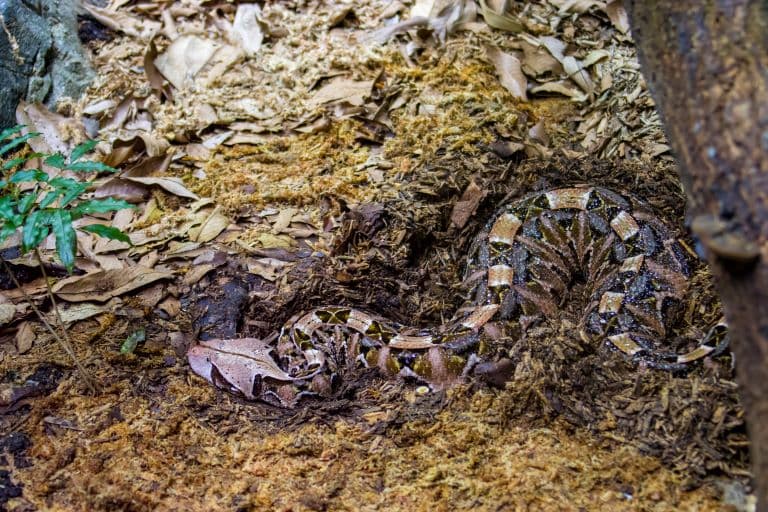Gaboon Viper Profile
In the rainforests of the Congo, there’s an elusive animal often known as the whisper. Sometimes it’s called the swampjack or butterfly adder – names that appear to suggest something ethereal and delicate.
Yet, this is one of the heaviest venomous snakes in the world, and also one capable of injecting one of the highest venom yields of any snake.
That’s enough venom to kill 30 men, and it can do so without ever being seen. Yet, the docile nature of the Gaboon viper represents the contrasting nature of this animal as a calm, yet deadly, killer.

Gaboon Viper Facts Overview
| Habitat: | Rainforests, savannas |
| Location: | Sub-Saharan Africa |
| Lifespan: | 20 years |
| Size: | 175 cm (69 in) – possibly 2.2m (7.2 ft) long |
| Weight: | 11.3 kg (25 lb) |
| Colour: | Pale blotches, contrasted with dark brown or purple, yellow-edged markings |
| Diet: | Small to medium mammals and birds, lizards, frogs |
| Predators: | None |
| Top Speed: | Slow |
| No. of Species: | 1 |
| Conservation Status: | Vulnerable (IUCN) |
Gaboon vipers are enormous, venomous snakes, and some of the most beautiful animals you’ll likely never spot on the forest floor.
Their stunning colouration and patterns help keep them hidden among the leaf litter of the tropical rainforests, and a pair of protrusions complete the illusion that this is nothing but foliage.
Yet, this snake has some serious weaponry, and won’t let go. Its lethal potential is offset by its peaceful and calm nature, but due to its reliance on camouflage, it does cause problems for farmers who risk stepping on it.
Still, this snake’s numbers are far more heavily threatened by humans than the other way around.
Interesting Gaboon Viper Facts
1. They’re big snakes
This snake is a true viper, but one that stands out among the family for its sheer size. With an average length of over a metre, it’s already a big snake, but the longest recorded have surpassed 2 metres in length.
Large individuals can weigh up to 10 kg, and this makes them big enough to take on animals as large as a small antelope.
Gaboon vipers are the heaviest venomous snake in Africa and only sit behind giants like the diamondback and king cobra as some of the heaviest in the world. 1

2. They’re beautiful
While they’re pretty chunky, they’re also stunning. Gaboon vipers are large and bulky snakes, with enormous, triangular heads and some seriously impressive colouration.
They have a symmetry of unique patterns down their body, with a base colour of brown or purple, covered in yellow triangles that mirror across the spine.
There are yellows, browns, oranges, sometimes blues and reds, too, and even their grey eyes, with a touch of silver, make this one of the best-looking animals in the forest.
3. They’re horny
On top of the huge, wide head sits a pair of little horns made from modified scales. This is something that shows up a lot in the viper family, and it appears to relate to their habitat.
Vipers that live in trees, such as the eyelash viper, have evolved to have eyebrow horns and those that live on the ground, seem to prefer horns on the nose.
These occurrences are thought to have evolved independently, and since the gaboon viper is terrestrial, it has nose horns. One of the major roles of these protrusions is thought to be a way to break up the pattern of the snake and help it blend in.
And if there’s one thing a gaboon viper does well, it’s blending in. 2
4. They’re extremely well camouflaged
This snake’s dazzling colouration only appears striking when it’s in a tank or attached to your arm. When sitting among the leaf litter of its chosen habitat, it functions to make it almost impossible to spot.
The markings on its back are almost leaf-shaped, and the snake spends most of its time stationary or barely moving.
These are ambush predators and don’t like to exert a lot of energy until the time comes to strike. As such, they are well known for being surprisingly calm snakes. 3

5. But they’re very docile
Even when picked up, the gaboon viper is unlikely to act very aggressively. They can be handled (by professionals) with ease, and aren’t likely to strike at all if the handler is careful and methodical.
The method of capturing one is said to involve a gentle tap on the head with some tongs to assess the aggression levels, and if all is well, reach down and grab it by the head. This species doesn’t appear all that eager to put up a fight, which makes it relatively easy to relocate.
Unfortunately, it’s this sluggishness that gets them, and the people they bite, into trouble. 4
6. Which can make them more dangerous
Camouflage is all well and good as long as the danger isn’t likely to crush you underfoot.
Many vipers rely on it to both hunt and avoid being hunted, but it doesn’t do a lot of good against a farmer stumbling around in the dark.
Where other species would flee, it stays put; as such, gaboon vipers are one of those species that occasionally get stepped on by mistake.
Sub-Saharan Africa experiences 30,000 deaths a year from snake bites, often in this manner, and often local governments are more inclined to spend money rigging elections than educate people on snake safety.
The result is often an indiscriminate slaughter of all snakes, regardless of species of intent.
And you can hardly blame people for being afraid – the gaboon viper’s bite is one of the worst you can get.
7. They have long fangs
That wide head houses incredible venom glands – some of the largest of any snake. They contain more venom than almost any other species and it’s administered through the longest fangs of any snake in the world.
These fangs can grow to 5cm long and are folded back under the hood until it’s time to release them. When striking, the fangs open forward, and on making contact, the snake, unlike other viper species, holds on.
Gaboon vipers can control how much or how little venom to inject, so often they’ll give a dry bite as a warning, but others aren’t so lucky.

8. They’re vulnerable
Persecution is a widespread issue with snakes in Africa, and the gaboon viper is not immune to this, but it’s also hunted for bushmeat and its beautiful skin.
Habitat destruction also plays a role, and over all of these factors, the species is now in decline and listed as vulnerable.
Gaboon Viper Fact-File Summary
Scientific Classification
| Kingdom: | Animalia |
| Phylum: | Chordata |
| Class: | Reptilia |
| Order: | Squamata |
| Family: | Viperidae |
| Genus: | Bitis |
| Species: | gabonica |
Fact Sources & References
- “Gaboon Viper”, IUCN Red List.
- “Habitat determines convergent evolution of cephalic horns in vipers”, Oxford Academic.
- “Gaboon viper”, Smithsonian’s National Zoo.
- Chandler’s Wild Life (2023), “World’s LONGEST FANGS! Gaboon Vipers!”, YouTube.
